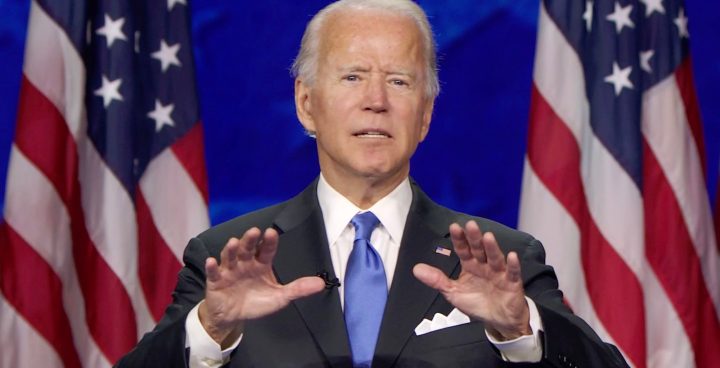Road to US Election
Virtual Democratic Convention 2020 makes history; shatters old conventional wisdom

Over four days, the Democratic Nominating Convention met — largely in the cloud — to nominate former Vice President Joe Biden to face incumbent President Donald Trump in the American presidential election. Besides a slew of innovative electronic connections, the convention also nominated California Senator Kamala Harris as its vice presidential candidate. Harris is the child of Indian and Jamaican immigrants and is the first black woman nominated for national office by either major political party. The convention featured speeches by the famous and average citizens alike, and there was even a display of an official state starter course, grilled calamari from Rhode Island, displayed to the world by video link.
What’s past, is prologue
Back in the 1930s, in the midst of The Great Depression, “The Cowboy Comedian” Will Rogers (an avid supporter of the Democratic Party, President Franklin D Roosevelt and his administration’s “New Deal” economic recovery policies) could always bring down the house when he delivered his trademark punch line: “I am not a member of any organised political party. I am a Democrat.” Given the intra-party struggles within the Democratic Party then and now, that internecine warfare has barely changed since Rogers’ time.
Aside from the personal rivalries that are the coin of every political party (South Africans are certainly familiar with that version of politics), a key reason for this intra-party political strife among Democrats is that the party — actually the oldest continuously existing political party in the world — has always been that it is a coalition of diverse groups and interests, in addition to a general adherence to often-vague, basic principles. (Historically, the party has reversed some of its original positions ever since Thomas Jefferson founded it, in light of the nation’s changed circumstances, challenges and leadership.)
“The Democrats dominated US politics from the 1930s through the 1960s because they included all kinds of people, from Southern segregationists to Northern liberals…”
The precise composition of the Democratic Party’s coalition has changed over time, and it has continued to evolve in response to changes in the national economy, external threats and the country’s demographics. (Jefferson had originally envisioned a party of sturdy yeoman farmers. He distrusted the cities and the growing role of the business class, and he wanted to maintain a small, limited government.) The reality is that the party is an often-unruly coalition, per Will Rogers, that often only warily fully coalesces in service of electing candidates and opposing its opponents. A distinct, pristine, pure ideology may take second place in all this for many supporters.
In response to the grave national crisis of The Great Depression, in the stretch of its most successful run of elections, in the era between 1932 to 1964, the coalition had bound together Southern segregationist political barons, white Southern and Midwestern small farmers and small businessmen, and the Northeastern and Midwestern working class and urban, ethnic constituencies, including northern blacks, unionised labour in factories, mines and railroads (including the all-black union of pullman sleeping car porters). The party became home for advocates for then-distinctly leftwing socialist measures (or something very much like that). And it included a coterie of public policy intellectuals, often drawn from the country’s small, but politically active Jewish population imbued with the traditions of leftist activism carried over from the Old World they had fled from earlier.
As Fareed Zakaria had also written in his most recent column: “The Democrats dominated US politics from the 1930s through the 1960s because they included all kinds of people, from Southern segregationists to Northern liberals. It was a Faustian bargain, but that coalition rescued the country from the Great Depression and passed Social Security, Medicare, food stamps, Head Start and a host of other programs that helped Whites and minorities alike.”
In the South, most especially, Democrats had been able to count on nearly-automatic support at the ballot box (by whites only) for nearly a century after the Civil War had ended in 1865. But this broad Roosevelt coalition was something new in American politics and it provided the basis for Franklin Roosevelt’s four wins, Harry Truman’s subsequent victory in 1948, and John Kennedy and Lyndon Johnson victories of 1960 and ’64. Dwight Eisenhower’s two victories in 1952 and ’56 are explained by his wartime fame, fatigue with a seemingly unending Korean conflict, and a public ennui with nearly continual Democratic presidents.
The components of the Roosevelt coalition stayed loyal to the party for decades, well into the early 1960s — save for two twin revolts by segregationists and hard left liberals in 1948 respectively under South Carolina Senator Strom Thurmond and then former cabinet member Henry Wallace, in revolt against a civil rights plank in the party’s campaign platform for Thurmond, and a push for a more accommodationist policy towards the Soviet Union by Wallace. However, beyond the broader changes in the national economy, the party’s unity increasingly faltered in a backlash against a growing push by Northern liberals for the civil rights legislation that would break down the legal bases of racial segregation.
This gave the Republicans, via Richard Nixon’s 1968 “Southern Strategy”, an opportunity to seize the loyalty of Democrats in the South, especially as the third party protest candidacy of arch-segregationist Alabama Governor George Wallace began to dissipate. By then, the allegiance of other elements of the Democratic coalition was weakening as well. The growing middle class “suburbanisation” of the American urban population led chunks of a formerly urban, solidly Democratic working-class population to move towards supporting Republicans. Moreover, the shrinking share of the economy represented by unionised industries with their Democratic Party-supporting, unionised workforce further encouraged the defection of another key pillar of the party as many of these individuals no longer felt the ancestral tug of party loyalty.
By the 1970s, beyond the loss of support in the South, successive failures of the progressive-liberal (and presumably elitist) presidential candidacies of George McGovern, Michael Dukakis, Walter Mondale and John Kerry focused attention on the weakening of the party’s old allegiances. Party leaders sensed Democrats could only succeed in a presidential race if they nominated racial and economic policy moderates who were Southern governors, such as Jimmy Carter or Bill Clinton if they hoped to build a modern, winning version of the Roosevelt coalition.
Why we are where we are now
When Barack Obama ran for president in 2008 and 2012, Democrats were increasingly cheerful he had crafted the correct strategy to forge a new and lasting electoral coalition. As a foundation, it would build on the large numbers of new voters in the latest generational cohorts, the rising political heft of African-Americans, Hispanics and other minorities, along with the cohort of largely white, middle-class, university-educated, suburban women increasingly poised to move beyond traditional ties to establishment Republican politics.
By the time Donald Trump ran for president in 2016 against Hillary Clinton, the gap between Democrats and Republicans in terms of political support from women had become seriously lopsided in favour of Democrats. While the Trump candidacy could capitalise on a special kind of populist revolt — largely among white, high school-educated, working and middle-class men angry at a governing class that seemed to be ignoring their anguish in the face of shrinking employment opportunities — it was also fed by racial antagonisms.
Despite this anger, it remains unclear such a support base can be an enduring electoral coalition in the manner of either the earlier Roosevelt or more recent Nixon/Reagan years. As a result, this election of 2020 now represents a potential clash of competing visions about a stable governing coalition for either party.
2020 and all that
For Democrats, their 2020 nominating convention was going to demonstrate just such a new, winning coalition and to blur the divisions within the party. This was to be the case, despite significant divisions over the relative importance of policies pushed by the new left wing of the party. There could be an angry fissure between the old centre-left exemplified by Joe Biden, versus the progressive-leftists in the Bernie Sanders, Alexandria Ocasio-Cortez wing of the party.
It became a four-day, two-hour-a-night mini-series as a festival of inclusivity, with star turns by big names and ordinary citizen unknowns alike.
Given the bitter experiences of Trump’s four years, the centre-left wing now focused on attracting independent voters and even a sizeable share of nominally Republican voters, even if it meant soft-peddling support for some of the measures touted by the progressive-leftist. For its part, the progressive-left seemed to believe it was more important to build support for a laundry list of its favoured policy ideas — even if that might risk losing hope for support from the undecideds or nominally Republican voters. (As noted earlier, this is not the first time such a division had broken out in the party. Recall the Henry Wallace walk-out of 1948, or, more recently, the movement of the party to support ultimately losing candidates like McGovern and Dukakis.)
The primary contests eventually boiled down to a struggle between the former vice president, Joe Biden (now on his third effort to gain the nomination), and Vermont’s democratic-socialist senator, Bernie Sanders (his second run at the nomination). The Sanders campaign counted on harnessing the enthusiasm of younger constituencies and heretofore marginalised communities for more fundamental changes in the country’s economic landscape.
By contrast, the Biden camp came to recognise that in the primaries, he would win or lose by gaining support from more centrist-style voters and, crucially, from the African American (increasingly female) base of voters who were loyal backers of Democrats. But by the time the primary season had ended, it was clear the Biden forces had actually gained significantly more total voters than Sanders had done and, in fact, Sanders’ total support was measurably lower than it was four years ago.
The task, going forward, then, for Biden and his team was to script a convention that demonstrated inclusivity, rather than a controversial, disruptive convention as had happened at times in the past for Democrats. There would be no sectarian, agenda-driven floor fight over platform provisions or candidates — let alone the possibility of a walkout by those disaffected by the now-inevitable outcome.
But then, enter Trump’s hat trick. The Covid-19 pandemic has continued to cut through the country, killing nearly 200,000 people and sickening millions more, even as disconnected, belated efforts to contain it has caused immense economic harm to many millions more. Moreover, from early summer onward, the racial turmoil stemming from outrage over police killings of younger black men after minor infringements of law did not die out — leading to protests across the nation, in tandem with the Black Lives Matter movement.
Given the pandemic, the original design for the Democratic convention in Milwaukee — picked because it boasted a long-time progressive tradition, a strong labour movement and its electoral significance as a must-win state — had to be scrapped. Suddenly, it had to be completely reengineered into a nearly all-virtual event.
It became a four-day, two-hour-a-night mini-series as a festival of inclusivity, with star turns by big names and ordinary citizen unknowns alike. The end result gave new life to a creaking formula, making it something of an adventure to watch (and for cynics to wait to see if the whole programme might collapse). Instead of the usual stemwinder of a speech, the keynote address featured over a dozen different people with short contributions; the voting by delegates on the nomination was live-streamed from 57 scenic locations across the states and territories; and speeches from activists working to improve comprehensive medical care, implementing gun control and focusing on environmental concerns.
But much expected highlights were speeches by Michelle Obama, Bernie Sanders, Bill Clinton, Barack Obama, Kamala Harris and Jill Biden. And Joe Biden’s formal acceptance of the nomination came right at the end of Thursday night’s proceedings where he hit a home run.
Michelle Obama offered a plangent conversation, almost as if she despaired that Trump had simply been unable to grow into the job he had taken, and had, instead, led the country in some dark, dangerous place. Sanders, meanwhile, compared Trump to Nero — the Roman emperor who fiddled as Rome burned, while Trump had gone off to play golf. In his speech, Bill Clinton lamented the divisive, economic collapse, and Jill Biden gave a truly warm, gracious, self-introduction that offered her life — and her husband’s — as models for being engaged with people’s real cares and fears.
Largely unknown to most people despite having been in the public eye for years, Jill Biden came across as a mensch, who had built a life with a man who would lead the nation — even as she pursued her career in education. Hillary Clinton reminded her audience that getting supporters to the polls is the most important thing, given the way the electoral system can reward a candidate who squeaks by in enough states to win the electoral college vote even while losing the popular vote (and she would certainly know something about that).
The prerecorded inserts of Biden on the train to and from his home in Wilmington to Washington every day portrayed a man who had really made friends with train staff, while the woman he encountered on an elevator frequently was so enthusiastic, she had been asked to second his nomination. Similarly, Senator Kamala Harris gave a self introduction designed to reveal her softer side, her inner life, and her family history, as well as the values she has stood for as a politician and prosecutor. But she also prosecuted the case against Trump.
As Washington Post columnist EJ Dionne observed: “In keeping with expectations that a vice presidential candidate will strike relentlessly at the opposition, Harris continued to online the Democratic National Convention’s assault on President Trump’s failures, lies and selfishness. But as prosecutors sometimes decide to do, she chose to speak not angrily or irritably, but in a tone of quiet sorrow over a country confronting pain, distress and exhaustion with a divisive and erratic president.”
As Harris said: “Donald Trump’s failure of leadership has cost lives and livelihoods. If you’re a parent struggling with your child’s remote learning, or you’re a teacher struggling on the other side of that screen, you know that what we’re doing right now isn’t working. And we are a nation that’s grieving. Grieving the loss of life, the loss of jobs, the loss of opportunities, the loss of normalcy. And yes, the loss of certainty… The constant chaos leaves us adrift. The incompetence makes us feel afraid. The callousness makes us feel alone. It’s a lot. And here’s the thing: We can do better and deserve so much more.”
Meanwhile, Barack Obama unleashed a rocket at Trump in contrast to the Joe Biden he knew. As Dionne noted: “Harris’s prosecutorial burden was also lightened by former president Barack Obama, who offered a sharp and urgent case for change. Obama’s 2020 speech on behalf of his former vice president was, in many ways, more passionate and more insistent than his case for his own reelection at the 2012 convention. As Obama said, he had hoped that when Trump took office, Obama had hoped the new president would at least ‘show some interest in taking the job seriously…’ and ‘discover some reverence for the democracy that had been placed in his care. But he never did.’”
Obama added that Trump has: “Shown no interest in putting in the work, no interest in finding common ground; no interest in using the awesome power of his office to help anyone but himself and his friends; no interest in treating the presidency as anything but one more reality show that he can use to get the attention he craves.”
Even in the midst of Obama’s speech, Trump was already in overdrive, tweeting away insults and innuendo in a way unprecedented during a convention speech by a former president, right along with his apparent endorsement of the truly bizarre conspiracy theory group, those QAnon hallucinators.
The final evening was pretty much all about Joe Biden, offering a window into his life history and his vision for the nation. When he stepped up to deliver his acceptance speech, there was speculation about how he would do in a room virtually devoid of people. But, giving the speech of his life he delivered the goods. Biden began with the idea that it is the job of leaders to “give people light and they will find a way” and help them choose hope over fear. For Biden, this coming campaign will be about winning the soul and the heart of America. Young people deserve a shot at America’s promise, despite the difficulties of the combined pandemic, the economic collapse, the renewed campaign for racial justice — and the accelerating threats of climate change.
For Biden, in this election, the choice could not be clearer as voters must judge the president on the facts. A second term for Trump will mean the wealthiest 1% will get new tax breaks, even as health insurance for many will evaporate. Biden offered harsh criticism of the president as a man who takes no responsibility for problems but then “cosies up to dictators”. “Is this the America you want for yourself and your children?,” he asked.
Biden, echoing others, said that the tragedy of Covid-19 is that “it didn’t have to be this way”. He promised that on his first day in office, he would implement a national strategy for immediate tests, deploy the equipment and supplies needed. Schools will have the resources to be open safely. He promised to take the advice of experts and make the wearing of masks a patriotic duty. Drawing inspiration from personal experience, he urged Americans, in the midst of loss and grief, to find purpose.
There were whistle stops at the Biden economic plan, there must be jobs, respect and dignity, with the construction of new infrastructure as a foundation for economic growth. They would build on the Affordable Care Act — Obamacare. They would deal with climate change — yes, it is a crisis, but also an opportunity for new, good jobs.
He promised that he was listening to young people who speak strongly about inequities and he promised to restore the promise of America for all. In that, the story of Kamala Harris is the American story and it is the duty of our generation to finally wipe out the stain of racism. And if you were listening closely for some words about foreign policy, there was the pledge that America would no longer play Mr Nice Guy to Russia and despots around the globe. That is one bodacious agenda, taken together.
Going forward
In the remaining 70-plus days before the actual voting day on 3 November 2020 (although millions of absentee/mail-in votes will have been cast well before that date), one crucial task for candidates Biden and Harris, besides attacking and attacking and attacking the Trump record, is going to be keeping this rambunctious, easy-to-find-slights coalition together, despite the inevitable disappointments among the progressive-left, the Biden-Harris ticket has not adopted every bit of the progressive-left’s agenda. Achieving that may be almost as difficult a balancing act as keeping up the outreach to disaffected Republicans, in line with the description of Biden as a calm, rational centrist by such convention speakers as former Ohio Governor John Kasich and retired general and Secretary of State Colin Powell, among others.
Going forward, too, there will also be the need to rebut the charges that will inevitably be made during the Republicans’ own largely virtual nominating convention the following week, as well as the continuing barrage of malicious, vitriolic, untruthful tweets from the president. There will be a crucial need to monitor government plans to make sure that somehow funds are not siphoned off from the postal service to cripple mail-in/absentee ballots from being counted, or to prevent mischievous charges of cheating and other shenanigans.
If Biden is lucky, his fractious party can hold it all together to delay the fight about the specifics of policies until after the election, as the Democrats look at the damage done to the nation by an outgoing Trump administration and then begin to repair it. Oh, on his first day, he will need to address the immediate trifecta of the pandemic, the economic collapse and the racial protests — even as a new administration will need to address the ongoing challenges of a now-thoroughly dysfunctional US-China relationship, among all the other international issues virtually crying out: “Deal with me first!” DM



















